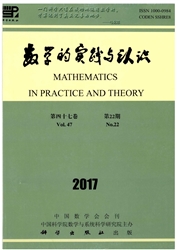

 中文摘要:
中文摘要:
测量数学模型建立后,测量不确定度评定需考虑输入量的不确定度及分布的传递性.若测量模型为幂指数积模型,通常先将输入量线性化,再采用合成方差的方法计算被测量的不确定度,方法计算简便,但未揭示不确定度随分布传递这一现象.针对问题,首先运用最大熵原理,计算测量仪器分辨力已知时,输入量的概率密度函数,其结果显示输入量服从矩形分布;其次重点推导了输入量与被测量之间为商概率模型时,被测量的概率密度函数、估计值和测量不确定度,并给出不确定度评定的具体步骤;最后利用恒流源测量高精密小电阻实例的对比分析,说明了该不确定度评定模型的可行性和有效性。
 英文摘要:
英文摘要:
After modeling the measurement, the transitivity of uncertainty and distribution of inputs should be taken into account in evaluation of uncertainty. In the event that the model belongs to power exponent product, linearization is used for inputs and compound variance is used to evaluate the uncertainty of measurand. This method is simple and ef- ficient, but can' t reflect the measurement transitivity along with distribution. Aiming at this problem, firstly, distribution functions of the inputs are derived using maximum entropy principle in given instrument resolution, which shows that the inputs obey uniform distri- bution. Then probability density function, mathematical expectation and the measurement uncertainty of measurand are deduced, when the functional relationship is division, and the steps of uncertainty evaluation is given. Finally, a contrastive analysis of high- precision resistancent is made, which shows the validity and feasibility of the model
 同期刊论文项目
同期刊论文项目
 同项目期刊论文
同项目期刊论文
 期刊信息
期刊信息
